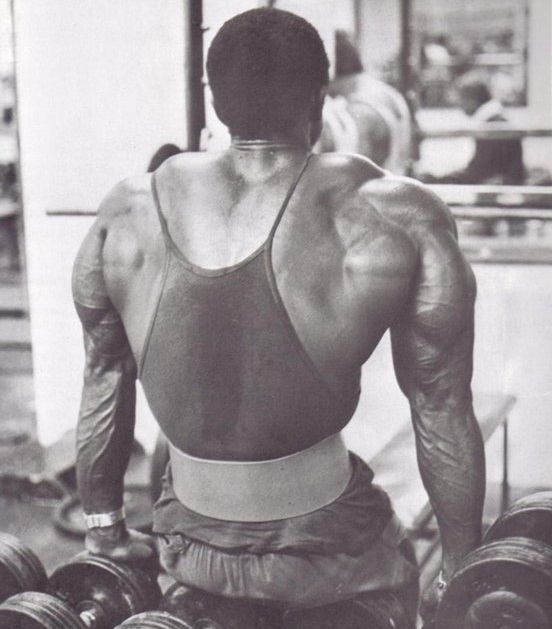“Failure is the true test of greatness.” – Herman Melville
To succeed in bodybuilding, you must learn how to fail.
This is not because most competitors lose, although they do. In a contest with 100 entrants, 99 will go home without the overall trophy. Still, nobody needs to practice for such placings. Nor is it because all humans, with the possible exception of Charlize Theron, will fall short of perfection. Try as we might, we can never ultimately build flawless physiques. This hard truth is part of the beauty of bodybuilding, but not the failure at issue here. The sort of bodybuilding failure you must learn is the one preordained every time you begin moving a weight, because that moment will always be followed by another when you stop moving it. All sets must end.
The key to training success is prolonging the inevitable failure of muscle or failure of will. This feature explains how to keep a set going even when your muscles and mind tell you to stop.

Why Does A Muscle Fail?
Let’s say you’re pumping out a set of barbell curls, certain you can perform a personal best of 10 full reps at that weight. Around the fifth rep, the pain begins a light warm ache. You keep going. Six. Seven. The pain increases. Now it’s a burning sensation. Still, you tell yourself you can’t stop until you get to 10. Eight. It’s torture now, but you won’t stop. Nine. No stopping, can’t stop, got to get that last rep. But you can’t. Your biceps seem to have simply given out.
What Happened?
It’s difficult to say why you didn’t get that 10th rep, because there are so many elements involved, starting with your biceps and your brain, but also including your skeletal, circulatory, respiratory and nervous systems. Still, the two most likely scenarios are your muscles (or, more specifically, the Golgi tendon organs) told your brain to stop the movement or your brain told your muscles to stop it. In the first case, a shutdown message was sent to your subconscious as you neared a threshold beyond which you had never passed before.
In the latter case, the increasingly painful buildup of lactic acid in your muscles worried you so much that you stopped. In both instances, your mind and body are trying to protect you from injuring yourself.
Taking A Closer Look

The first thing you should know is that, in fact, you were probably not very close to injuring yourself. Certainly, there would be a greater chance of trauma during the struggle for that 10th rep than during, say, the fourth rep of the same set. If something is going to give out, it will typically happen when taxed more rather than less.
Still, the odds of injury would’ve been small had you maintained proper form. Your body and your brain were being extra cautious.
Beyond Failure
The other thing to know is that there is such a thing as true muscle failure. Just as you can’t go 100 miles per hour on a riding mower (at least not without some serious modifications), you can’t curl 1,000 pounds, and it’s not your Golgi tendon organs or lactic acid buildup that’s holding you back. Every muscle has a strength threshold. That said, in most cases, your brain shuts down your muscles before they’ve even approached that threshold.
After all, there are stories about slender women, flush with adrenaline, who have hoisted cars to free trapped children. That should be all the proof you need that your body is capable of much more than your mind usually lets it attempt.
Set Expansion
Failure is that moment when you simply cannot complete another full repetition with strict form. Of course, you should be continuously striving to increase your reps and/or weights over the long term, and there are many factors involved in strength increases, starting with a properly formulated routine and the right diet. At that very moment when you’re failing, the key to squeezing out one more rep is almost entirely mental. A training partner can offer encouragement, but you have to will that weight up one more time. Let’s say you can’t get one more rep or, better yet, you somehow manage to do one more, but you certainly can’t do two more.
Eventually, there comes a time when you cannot complete another full rep without cheating, shortening the reps, pausing for a few seconds, decreasing the weight or getting some help.
These five approaches are set-expansion techniques, and they can push a set beyond the normal limits of failure. The fact that any set can be extended by changing variables tells you that your muscles were not fully taxed via full reps. To thoroughly exhaust bodyparts by expanding the set (taking the working muscle past the normal point of failure), you need to incorporate one or more of the Weider Training Principles discussed in this feature.

The choice of which technique to utilize is up to you. All but forced reps can be performed alone. Incorporating each of them at various times will provide you with ample variety and thus keep your muscles guessing and growing.
When Should A Set End?
Not every set should go to failure. When pyramiding your sets (going progressively heavier with lower reps each set), your initial higher-rep sets should not be especially intense. Indeed, you may want to focus all of your energy at the top of the pyramid and not go to failure in any of your sets. Potentially dangerous lifts such as bench presses and squats should never go to failure without spotters. If you’re training more for rehabilitation or toning than for muscle mass, it’s not prudent to test your limits. Barring those exceptions, you should push most sets to failure or near-failure.
This is the key to effective weight training. Using these going-past-failure techniques, you overload the muscle with a stress it hasn’t previously experienced, so it is forced to grow in size and strength.
Beyond Failure
Knowing when to go beyond failure is more difficult to ascertain. The five set-expansion techniques outlined here can significantly boost the intensity of your workouts. If you’ve never used them before, your muscles are in for a shock. Utilizing them without incorporating enough rest will lead to overtraining, so you may want to limit their use to one extended set per bodypart. If you want to utilize them more often, work out less frequently and/or do fewer sets per bodypart. There’s a reason why high-intensity adherents such as Dorian Yates do less volume than other champs: By going to failure and beyond, their muscles quickly get fully taxed. Greater volume would be counterproductive.
If pushing your sets to failure means that your workouts need to be shorter or less frequent, so be it. Train as hard as you can, go home and grow. Don’t fear failure in the gym. Confront it and, at least some of the time, challenge it by expanding your sets beyond previous boundaries. When it comes to stimulating maximum muscle growth, failure is a bodybuilder’s best friend.

1: Weider Cheating Principle
Once failure (i.e., inability to complete a full rep with perfect form) is reached, perhaps the easiest way of extending the set is via the Weider Cheating Training Principle. In this context, “cheating” means moving the weight through the full range of motion of a particular exercise, but, instead of using perfect form, using the momentum of the weight or body sway to help move the poundage. For instance, rather than keeping your torso rigid during barbell curls, you can sway backward and then forward as you curl the weight upward. Despite admonitions throughout your life not to cheat, there is nothing wrong with cheating when weight training, if it’s kept to a minimum and done under the right circumstances.
Remember This
Cheating should be a way of extending a set when failure to perform a full rep kicks in, not merely a way of moving more weight during a set. Let’s say you reach failure on the sixth rep of a set; at that point, you can implement controlled cheating and do two or three cheat reps. (If you can do more, you didn’t really reach failure to do a full rep at the sixth rep.)
Keep momentum in check. Merely swinging the weight up as though your arms are pendulums will have little effect on your muscles and greatly increase the risk of injury.
Best movements for using this principle:
Barbell and dumbbell curls, barbell shoulder presses, lateral raises and rear-delt flyes.
Don’t use this principle for these exercises:
Compound movements such as deadlifts, barbell rows, squats and bench presses
2: Weider Partial Reps Principle
 After performing all the full reps you can muster, you can still invariably grind out several partial reps. This is when the Weider Partial Reps Training Principle comes into play. Returning to our barbell curl example, after reaching failure at 10 reps and still keeping perfect form intact, curl the weight up as far as you can. Perhaps you’ll be able to curl it only halfway. That’s fine. Your muscles are still working; that’s the important thing. The next time, you may not even be able to make it halfway. For the next couple of reps, you may be able to complete only a quarter of the range of the movement. You’ll quickly reach a point where you can move the barbell only a few inches from your thighs, and yet you should be able to do this short movement numerous times perhaps five or six.
After performing all the full reps you can muster, you can still invariably grind out several partial reps. This is when the Weider Partial Reps Training Principle comes into play. Returning to our barbell curl example, after reaching failure at 10 reps and still keeping perfect form intact, curl the weight up as far as you can. Perhaps you’ll be able to curl it only halfway. That’s fine. Your muscles are still working; that’s the important thing. The next time, you may not even be able to make it halfway. For the next couple of reps, you may be able to complete only a quarter of the range of the movement. You’ll quickly reach a point where you can move the barbell only a few inches from your thighs, and yet you should be able to do this short movement numerous times perhaps five or six.
These short reps at the end of a set are called burns, and they’re appropriately titled. As you move far beyond failure, burns will indeed create a smoldering sensation in your muscles, a sure sign that you’ve fully taxed the targeted area. Burns can also be performed after the other set-expansion techniques to truly push a set far beyond its normal limits.
Best movements for using this principle:
Good for all exercises.
3: Weider Rest-Pause Principle
In addition to cheating the bar up or grinding out partial reps, you’ve probably noticed that if you pause long enough, you can perform more reps. A fatigued muscle can regain 50-60% of its strength with only 10-15 seconds of rest. The Weider Rest-Pause Training Principle prescribes that you rest briefly after failure is reached. Release or lower the weight, rest 10-15 seconds, then do another two or three reps; rest another 10-15 seconds, then perform another two or three reps.
This is an intense process, and it means you are extending the set beyond muscular failure, while still moving maximum poundage with good form.
Best movements for using this principle:
Barbell military presses off a rack or machine, bench presses off a rack or machine, leg presses and hack squats
Don’t use this principle for these exercises:
Isolation movements such as cable crossovers, cable flyes, triceps pressdowns and cable curls; squats, deadlifts and dumbbell movements
4: Weider Descending Sets Principle
It follows that if you reach failure after eight barbell curls with 100 pounds, you should still be able to do some additional reps with, say, 80 pounds. The Weider Descending Sets Training Principle is the method for quickly reducing the weight after your initial full reps. For instance, when curling 100 pounds and reaching failure at the eighth rep, grab another bar or strip weights off the first bar and curl 80 pounds for three or four additional reps. Then, when you cannot complete another full perfect rep with 80 pounds, reduce the weight to 60 and do another three or four reps.
Perhaps you’ll then reduce the weight to 50 pounds and complete as many reps as you can at that weight. Two or three weight reductions are generally sufficient when expanding a set.

Photography By: Alex Ardenti
Best movements for using this principle:
Exercises in which weights can be quickly adjusted, such as lat pulldowns, triceps pressdowns, cable curls and dumbbell curls (off a rack); and machine exercises
Don’t use this principle for these exercises:
Exercises in which weights take a while to change; plate-loaded cambered-bar movements, such as preacher curls, biceps curls, lying triceps presses and triceps extensions; barbell exercises without a partner, such as bench presses, incline bench presses and barbell shoulder presses; and leg presses
5: Weider Forced Reps Principle
 The other four techniques discussed in this feature can all be performed alone, but to incorporate the Weider Forced Reps Training Principle, you’ll need the services of at least one spotter. Returning to our set of barbell curls, once you’ve reached failure doing full reps on your own, your partner should step in, place his fingers under the bar and give only minimum assistance. The key to these “forced reps” is that your spotter helps you out only enough to keep the bar moving through a full range of motion. He may only need to barely touch the bar for the first two forced reps. You’ll be doing most of the work. For subsequent reps, your spotter will invariably have to help you more and more, but he should never do more work than you.
The other four techniques discussed in this feature can all be performed alone, but to incorporate the Weider Forced Reps Training Principle, you’ll need the services of at least one spotter. Returning to our set of barbell curls, once you’ve reached failure doing full reps on your own, your partner should step in, place his fingers under the bar and give only minimum assistance. The key to these “forced reps” is that your spotter helps you out only enough to keep the bar moving through a full range of motion. He may only need to barely touch the bar for the first two forced reps. You’ll be doing most of the work. For subsequent reps, your spotter will invariably have to help you more and more, but he should never do more work than you.
If you truly reached failure on your own, your strength should drop off quickly when expanding a set, so three or four forced reps should suffice.
Best movements for using this principle:
Bench presses, shoulder presses, barbell curls and machine exercises
Don’t use this principle for these exercises:
Compound movements such as squats, deadlifts and barbell rows
Author: Greg Merritt
References:
http://www.muscleandfitness.com/
http://www.flexonline.com/
COPYRIGHT 2011 Weider Publications
COPYRIGHT 2011 Gale Group










